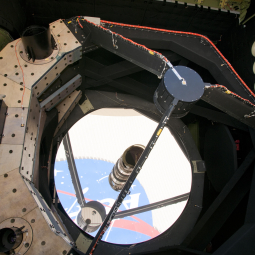The SOFIA Science Center announces selection of astrophysics research programs for science flights during the observatory’s fourth annual cycle of operations. These investigations will be conducted from February 2016 through January 2017, including a deployment to the Southern Hemisphere planned for mid-2016.
A list of the selected SOFIA Cycle 4 programs is available on the results page .
These programs include investigation of the history of water on Mars, a search for remnant signs of planet formation around nearby stars, and a comprehensive study of star formation processes across an entire galaxy.
“The Cycle 4 investigations have the potential to make substantial contributions to a remarkably broad range of astronomy research areas,” said SOFIA Science Mission Operations (SMO) Director Erick Young of the Universities Space Research Association (USRA).
“We will employ six of SOFIA’s scientific instruments, two of which have capabilities new to SOFIA, to make these observations,” elaborated SMO Deputy Director Hans Zinnecker of the German SOFIA Institute (DSI). The selected projects will showcase SOFIA’s unique assets and capabilities.”
U.S. and German review panels comprised of experts drawn from the scientific community evaluated the scientific merits of submitted proposals. NASA awarded a total of 478 hours of SOFIA guest observer time and NASA’s partner the German Aerospace Center (DLR) awarded 80 hours, to be carried out during 106 science flights planned for the next year. Other observing hours during those flights will be allocated for other purposes such as calibration measurements and scientific programs of SOFIA’s instrument teams.
SOFIA is a substantially modified Boeing 747SP aircraft that carries a telescope with an effective diameter of 100 inches (2.5 meters) at altitudes up to 45,000 feet (14 km), above the obscuring layer of water vapor in Earth’s atmosphere.
The SOFIA program is a partnership of NASA and DLR. NASA's Ames Research Center located in Moffett Field, California manages the SOFIA science mission in cooperation with USRA, located in Columbia, Maryland, and DSI, located in Stuttgart, Germany. The SOFIA aircraft is based at the NASA Armstrong research aircraft operations facility in Palmdale, California.
Points of Contact
Nicholas A. Veronico
SOFIA Science Center, NASA Ames Research Center, Moffett Field, Calif.
650-224-8726
nicholas.a.veronico@nasa.gov
/
nveronico@sofia.usra.edu
Kate K. Squires
Armstrong Flight Research Center, Edwards, Calif.
661-276-2020
kate.k.squires@nasa.gov
